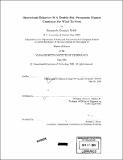Operational behavior of a double-fed permanent magnet generator for wind turbines
Author(s)
Reddy, Sivananda Kumjula
DownloadFull printable version (10.65Mb)
Other Contributors
Massachusetts Institute of Technology. Dept. of Electrical Engineering and Computer Science.
Advisor
James L. Kirtley, Jr.
Terms of use
Metadata
Show full item recordAbstract
Greater efficiency in wind turbine systems is achieved by allowing the rotor to change its rate of rotation as the wind speed changes. The wind turbine system is decoupled from the utility grid and a variable speed operation is implemented. Since wind speed varies, the shaft speed should too. But electrical output frequency should be synchronous and Induction machines on their own do not allow for variable ratio of shaft speed to electrical frequency. Permanent Magnet (PM) machines have major advantages: Efficiency and power density are both high: they are also inherently synchronous. A prototype ([approx]20 kW) of a novel hybrid machine that encompasses the desired features of Permanent Magnet Generators and Doubly-Fed Induction Generators (DFIGs) is being built. This novel geometry machine has to be tested for stability on a test-bed and controlled using an appropriate power electronics and controller circuit. A MATLAB 5th order model of the machine is built, linearized. simulated and examined for stability. The dynamics of the PM rotor is studied. The electrical equivalent behavior of this component of the machine is vital because the frequency of the output power is a direct function of its mechanical speed. As a culmination of this research work, possible paths for the scope of future work on this technology is presented. (cont.) Keywords: wind turbines, modified torus geometry, permanent magnet, doubly-fed induction. dynamic state-space model, electromechanical stability analysis.
Description
Thesis (S.M.)--Massachusetts Institute of Technology, Dept. of Electrical Engineering and Computer Science, 2005. Includes bibliographical references (leaves 117-118).
Date issued
2005Department
Massachusetts Institute of Technology. Department of Electrical Engineering and Computer SciencePublisher
Massachusetts Institute of Technology
Keywords
Electrical Engineering and Computer Science.